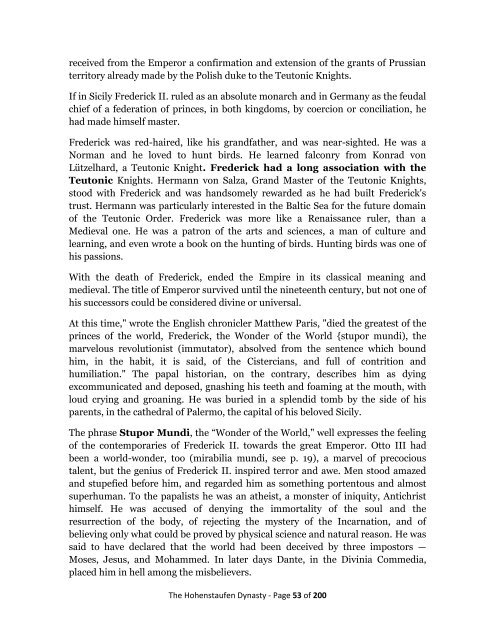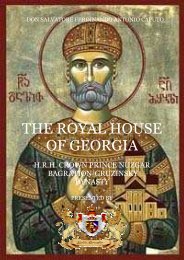here - Nobility Associations
here - Nobility Associations
here - Nobility Associations
Create successful ePaper yourself
Turn your PDF publications into a flip-book with our unique Google optimized e-Paper software.
eceived from the Emperor a confirmation and extension of the grants of Prussian<br />
territory already made by the Polish duke to the Teutonic Knights.<br />
If in Sicily Frederick II. ruled as an absolute monarch and in Germany as the feudal<br />
chief of a federation of princes, in both kingdoms, by coercion or conciliation, he<br />
had made himself master.<br />
Frederick was red-haired, like his grandfather, and was near-sighted. He was a<br />
Norman and he loved to hunt birds. He learned falconry from Konrad von<br />
Lützelhard, a Teutonic Knight. Frederick had a long association with the<br />
Teutonic Knights. Hermann von Salza, Grand Master of the Teutonic Knights,<br />
stood with Frederick and was handsomely rewarded as he had built Frederick's<br />
trust. Hermann was particularly interested in the Baltic Sea for the future domain<br />
of the Teutonic Order. Frederick was more like a Renaissance ruler, than a<br />
Medieval one. He was a patron of the arts and sciences, a man of culture and<br />
learning, and even wrote a book on the hunting of birds. Hunting birds was one of<br />
his passions.<br />
With the death of Frederick, ended the Empire in its classical meaning and<br />
medieval. The title of Emperor survived until the nineteenth century, but not one of<br />
his successors could be considered divine or universal.<br />
At this time," wrote the English chronicler Matthew Paris, "died the greatest of the<br />
princes of the world, Frederick, the Wonder of the World {stupor mundi), the<br />
marvelous revolutionist (immutator), absolved from the sentence which bound<br />
him, in the habit, it is said, of the Cistercians, and full of contrition and<br />
humiliation." The papal historian, on the contrary, describes him as dying<br />
excommunicated and deposed, gnashing his teeth and foaming at the mouth, with<br />
loud crying and groaning. He was buried in a splendid tomb by the side of his<br />
parents, in the cathedral of Palermo, the capital of his beloved Sicily.<br />
The phrase Stupor Mundi, the “Wonder of the World," well expresses the feeling<br />
of the contemporaries of Frederick II. towards the great Emperor. Otto III had<br />
been a world-wonder, too (mirabilia mundi, see p. 19), a marvel of precocious<br />
talent, but the genius of Frederick II. inspired terror and awe. Men stood amazed<br />
and stupefied before him, and regarded him as something portentous and almost<br />
superhuman. To the papalists he was an atheist, a monster of iniquity, Antichrist<br />
himself. He was accused of denying the immortality of the soul and the<br />
resurrection of the body, of rejecting the mystery of the Incarnation, and of<br />
believing only what could be proved by physical science and natural reason. He was<br />
said to have declared that the world had been deceived by three impostors —<br />
Moses, Jesus, and Mohammed. In later days Dante, in the Divinia Commedia,<br />
placed him in hell among the misbelievers.<br />
The Hohenstaufen Dynasty - Page 53 of 200



